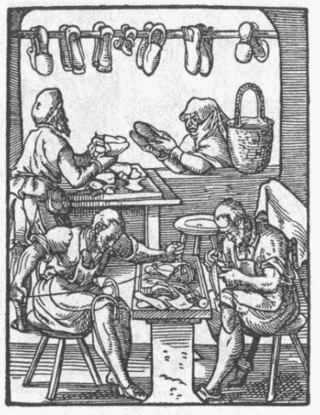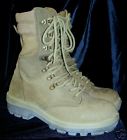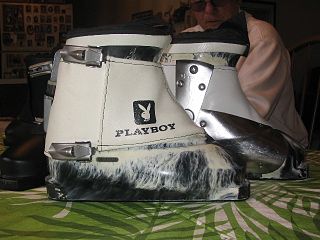
A shoe is an item of footwear intended to protect and comfort the human foot. Though the human foot can adapt to varied terrains and climate conditions, it is vulnerable, and shoes provide protection. Form was originally tied to function, but over time, shoes also became fashion items. Some shoes are worn as safety equipment, such as steel-toe boots, which are required footwear at industrial worksites.

A boot is a type of footwear. Most boots mainly cover the foot and the ankle, while some also cover some part of the lower calf. Some boots extend up the leg, sometimes as far as the knee or even the hip. Most boots have a heel that is clearly distinguishable from the rest of the sole, even if the two are made of one piece. Traditionally made of leather or rubber, modern boots are made from a variety of materials.

The Wellington boot, often shortened to welly and also known as the gumboot, is a type of waterproof boot.

Dr. Martens also known as Doc Martens, Docs, or DMs, is a footwear and clothing brand, headquartered in Wollaston, Northamptonshire. Although famous for its footwear, the company also makes a range of accessories including clothing and bags. The footwear is distinguished by its air-cushioned sole, upper shape, welted construction, and yellow stitching. The Dr Martens' design studio is in Camden Town, London, England. The company manufactures in the UK, China, Vietnam, Laos, and Thailand. The company is listed on the London Stock Exchange and is a constituent of the FTSE 250 Index.

Shoemaking is the process of making footwear.

Combat or tactical boots are military boots designed to be worn by soldiers during combat or combat training, as opposed to during parades and other ceremonial duties. Modern combat boots are designed to provide a combination of grip, ankle stability, and foot protection suitable for a rugged environment. They are traditionally made of hardened and sometimes waterproofed leather. Today, many combat boots incorporate technologies originating in civilian hiking boots, such as Gore-Tex nylon side panels, which improve ventilation and comfort. They are also often specialized for certain climates and conditions, such as jungle boots, desert boots, and cold weather boots as well as specific uses, such as tanker boots and jump boots.

Jungle boots are a type of combat boot designed for use in jungle warfare or in hot, wet, and humid environments where a standard leather combat boot would be uncomfortable or unsuitable to wear. Jungle boots have vent holes in the instep and sometimes a canvas upper to aid in ventilation and drainage of moisture.

Jump boots are a type of combat boot designed for paratroopers featuring calf-length lacing and rigid toe caps. The style was developed in many countries simultaneously with the adoption of airborne infantry forces during World War II. Modern jump boots are earned in some countries and therefore have become a mark of achievement and distinction, mainly worn as dress and parade boots. The uppers are generally made of smooth black leather with toe-caps and heel counters that accept a high polish. It is also a paratrooper tradition to lace jump boots in a ladder or cobweb style which increases ankle support during a parachute jump.

Galoshes, also known by many other names, are a type of overshoe or rubber boot that is put on over shoes to keep them from getting muddy or wet during inclement weather.

An Australian work boot is a style of work shoe, typically constructed with a leather upper bound together with elastic sides and pull tabs on the front and back of the boot. The shoe lacks a tongue, and laces, and often contains a steel toe cap for occupational health and safety reasons. When the shoe contains a steel cap they are often known as "safety boots" or "steel toe boots". The boots generally lack an inner lining. The sole is generally polyurethane and the leather uppers are treated to be resistant to hot water, fats and mild alkaline and acid solutions.

Football boots, called cleats or soccer shoes in North American English, are a type of shoe worn when playing association football (soccer). Those designed for grass pitches have studs on the outsole to aid grip. From simple and humble beginnings football boots have come a long way and today find themselves subject to much research, development, sponsorship and marketing at the heart of a multi-national global industry. Modern "boots" are no longer truly boots in that they do not cover the ankle - like most other types of athletic footwear, their basic design and appearance has converged with that of sneakers since the 1960s.

Engineer boots, also known as engineer's boots or engineering boots, are an American type of traditional leather work-boots. Their lace-less, rugged construction made them popular among motorcycle riders. Originally developed in the 1930s for firemen working on steam locomotives, the boots gained substantial popularity in the post–World War II era during a growing motorcycling culture. They became popular symbols of teenage rebellion in the 1950s and a common component of greaser wear. They were later adopted by skinheads and punks in the 1970s. By the 2010s, engineer boots were being popularly worn for fashion purposes, especially by non-traditional customers such as women, young urban professionals, and hipsters.

A moccasin is a shoe, made of deerskin or other soft leather, consisting of a sole and sides made of one piece of leather, stitched together at the top, and sometimes with a vamp. The sole is soft and flexible and the upper part often is adorned with embroidery or beading. Though sometimes worn inside, it is chiefly intended for outdoor use.
Veldskoene ("FELT-skoona") or colloquially vellies ("FELL-ys") are South African walking shoes made from vegetable-tanned leather or soft rawhide uppers attached to a leather footbed and rubber sole by a method known as stitchdown construction, done without tacks or nails.

Solovair is a brand of British-made boots and footwear, produced by NPS Shoes Ltd., which was established in 1881. The NPS factory is based in Wollaston, Northamptonshire, an area known for its shoe industry. NPS shoes are known for their Goodyear welt technology which is used in all their shoe production. This particular technique is needed to fix the Solovair sole onto "Soft Sole Suspension" boots and shoes.

Chukka boots are ankle-high leather boots with suede or leather uppers, leather, wooden or rubber soles, and open lacing, with two or three pairs of eyelets. The name chukka possibly comes from the game of polo, where a chukka is a period of play.

Cowboy boots are a specific style of riding boot, historically worn by cowboys. They have a high heel that is traditionally made of stacked leather, rounded to pointed toe, high shaft, and, traditionally, no lacing. Cowboy boots are normally made from cowhide leather, which may be decoratively hand-tooled, but are also sometimes made from "exotic" skins like alligator, snake, ostrich, lizard, eel, elephant, stingray, elk, buffalo, and so on.

Rosemount Ski Boots introduced one of the earliest all-plastic ski boots for the downhill skiing market, competing with Bob Lange for the title of "first". Rosemount's design was easily distinguished by its use of the uncommon "side-entry" method for putting the boot on, which was rare at the time and is no longer used.

A desert combat boot is a type of combat boot designed specifically for use in humid or arid regions for desert warfare, where a traditional or standard issued black leather combat boot might be deemed uncomfortable or unnecessary. Like jungle boots, desert boots may implement similar designs; such as nylon canvas sides, speed lacing, and drainage vents on the instep. Boots made for desert warfare may commonly come in colors such as tan or beige, and range from dark to lighter versions of the two.

Bean boots are a type of water-resistant "duck boots" manufactured by L.L.Bean. They are constructed from a rubber sole and a leather upper. The boots were created in 1911 and were an instant success. The boots became an item of clothing connected to elite prep schools. In the 2010s, the boots experienced a resurgence in popularity leading to a shortage, as demand exceeded production capacity.


















